Due to their tremendous adaptability and tenacity, mice are notorious for entering homes in search of shelter, food, and warmth. As homeowners, it is essential to be aware of the most frequent entry points mice use to obtain access to your home. By understanding these weaknesses, you can take preventative measures to seal them off and thwart the entry of these unwanted visitors.
Walls and foundations with holes and fissures
Mice can easily gain access to your residence through small exterior openings. These agile rodents can exploit even the smallest holes in walls, foundations, and sheathing. Due to the fact that mice can fit through openings as small as a dime, it is essential to thoroughly inspect the exterior of your home for any gaps or openings that need to be sealed.
Openings and Vents
Mice are able to pass through ducts, soffits, and exhaust fans. These animals may gain access to your home through roof vents, gable vents, and crawl space vents. Mice can be prevented from entering your residence by installing mesh screens over these openings while still allowing for adequate ventilation.
Transmission Lines and Pipes
Utility lines and pipes frequently penetrate homes through tiny cracks in the foundation or walls. These spaces provide mice with convenient access locations. Steel wool and caulk can be used to fill the spaces around pipelines and utility lines to prevent rodents from entering.
Windows and Doors
Mice are adept climbers and can enter through openings or doors and windows that have been left ajar. The use of weatherstripping and door sweeps can help create a tighter seal, decreasing the likelihood of rodents gaining access. Ensure that windows are adequately screened and in good condition.
Garage Entrances
The carport is also a vulnerable location. Mice can enter through garage door openings, damaged weather seals, and even foundation cracks. Inspect and maintain your garage on a regular basis to minimize these entry points.
Roofing and Eaves
Overhanging tree branches or ivy can serve as a bridge for mice to gain access to your roof and enter your residence. Cut back vegetation and remove any overhanging branches that could serve as rodent pathways.
Basement and Crawl Spaces
Mice frequently exploit concealed entryways in crawl spaces and basements. Examine the foundation, vents, and crawl space access doors for openings. Installing mesh or using sealants can help prevent rodents from entering a structure.
Access points in attics
Mice can gain access to your attic through damaged vents, loose shingles, and crevices in the eaves. Perform routine inspections of your attic and address any vulnerabilities immediately.
Openings for Plumbing and Electrical Systems
Mice can enter your residence through gaps around plumbing and electrical conduits. These apertures must be sealed with the appropriate materials to prevent mouse access.
Outdoor Storage and Disorganization
Near your residence, clutter such as firewood, leaves, and debris can provide mice with places to hide. These hiding places can serve as stepping stones for mice to infiltrate your home.
Preventing Mouse Entry Is Your Primary Defence
The prevention of mice requires a combination of vigilance and proactive measures. Regularly inspect your home for security flaws and resolve any that you find immediately. Seal cracks, install mesh screens, and reinforce entry points to make it as challenging as possible for rodents to enter your home. By taking these measures, you can create an impregnable defence against these intelligent and persistent invaders, protecting your family from rodent infestations.
Affordable, accessible, and high-quality mouse control bowmanville. We remove mice from private and commercial properties with the help of our licensed and insured technicians that have years of experience.

